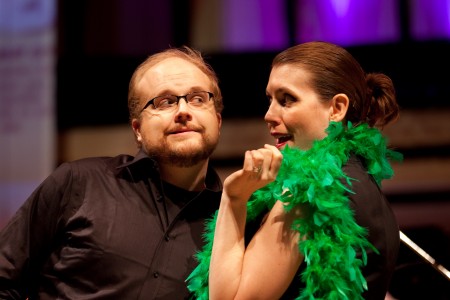Dark Star Requiem was on stage for two nights only to open Toronto’s LuminaTO Festival
by Ryan Kerr
The world premiere of Dark Star Requiem – commissioned by Toronto’s Luminato 2010 Festival and co-produced with Tapestry New Opera – characterized the world AIDS epidemic with the flow of a Wikipedia article, the atonal melodies of modern oratorio, and the staging of a low-budget musical.
In addition to writing for Mooneyontheatre.com, I work part time in the social service sector. I attend weekly HIV-related lectures on topics ranging from antiretroviral therapy interactions to the complicated factors which comprise the social determinants of health – essentially how social, economic, and cultural factors influence disease transmission and medical care.
Those who access the services in this community would be acutely aware of the wealth of information missing from Dark Star Requiem. They work hard to tell a new story of HIV/AIDS disease and treatment – one of global community, scientific advancements, and the emergence of a growing and brave community despite religious and social judgement.
Some 2010 issues include dealing with HIV/AIDS and osteoporosis, as newer treatments maintain the disease so effectively that those effectively live as long as everybody else. I realize that I have more base knowledge than many other audience members, but I should not have felt that I knew more than the creators of a commissioned piece discussing this very topic.
Dark Star Requiem began with the full chorus of Elmer Iseler Singers, featured soloists, percussionists, and the Gryphon Trio in white lab coats singing the numbers “00 061 1 06 009” and “00 061 1 06 010”. While these are the International Committee on Taxonomy of Viruses’ numerical attribution to HIV-1 and HIV-2, I felt like I was listening to a sung rendition of The Matrix screensaver I had from 1999 – 2001. The simultaneous projections of falling numbers looked more like computer code than taxonomy, especially when following a projection which compared the number of AIDS related deaths to the “number of Americans who have illegally downloaded a full-length movie from the internet”. Everyone laughed.
The audience was then taken on a loose narrative journey from the dramatic rendition of the first suspected case of HIV in 1959, through stereotypical imagery of burning chaos of the Third World in a section entitled “Congo and one of the 4H’s”. (Initially, cases of HIV appeared only in Heroine addicts, Homosexuals, Hemophiliacs, and Haitians, according to 1980s hysteria.) The narrative then traced early theories of dispersion – “polygyny” and “gay plague” and to medical achievements (“3 ingredient cocktail”) which compared the perfection in the ingredients of a rum and coke to antiretroviral therapies. Finally, we arrived at the gloomy present day with a true requiem, mourning the loss AIDS has impressed upon our world.
Each chapter was comprised of a clashing combination of music, drama and story – despite the talented cast which included Soprano soloist Neema Bickersteth and Bass-Baritone Marcus Nance – the material was so choppy that in many cases the audience recoiled from the sharp bangs of percussion. The gulf of meaning between what was said/sung and what was projected was also unnerving.
For example: with the title “beauty marks” projected above him, the protagonist Peter McGivillivray mimed discovery of Kaposi’s Sarcoma[1] lesions while Neema Bickersteth personified the AIDS Virus and wrapped him in crimson cloth. Mr. McGillivray had his back turned to the audience, ashamed.
Need we discuss morality when referring to an illness? In reality, the fight against HIV/AIDS is made more complicated by the tendency by health care professionals and the general public to do exactly the same thing. I felt like I was having flashbacks to Roger Spottiswoode’s And the Band Played On, a 1993 made-for-TV-movie about the origins of the AIDS Virus, complete with the terror and discrimination associated with its treatment and education. While groundbreaking for its time, I felt similar sentiments in Dark Star Requiem, seventeen years later.
On stage, two plywood coffins were used as drums while Ms. Bickersteth spoke the story of what seemed a non-specific African burial ritual, in a non-specific African accent no less. The singers and musicians in white coats parroted her sentiments verbatim. Intricate projections created by Beth Kates and Ben Chaisson created walls of cellular mitosis, raging fires, and finally, a photo montage with those presumably affected/infected by HIV/AIDS.
The house lights went up just before her tale drew to a close. The stage cleared with no curtain call.
I was left feeling like we too should walk away from this terrible situation, and not return to face our audience. Instead of presenting some of the advances in science and technology, access to care, world-wide collaboration to address ancient systemic issues of class, gender, and sexuality, Dark Star Requiem retold encyclopedia knowledge.
Encyclopedias tell us that HIV/AIDS is a terrible, devastating and debilitating blight on the world – especially in Africa. However, with rates of infection in certain communities here in Canada similar to/in excess of those in so-called endemic areas, perhaps choosing to close with a generalized African example is in error.
Musician Andrew Staniland and poet Jill Battson’s collaboration in Dark Star Requiem failed to convey any new ideas – choosing instead to regurgitate old theories, and, I fear, promote the same fatal stigma which perpetuates this infection globally. Before this is shown again, I would hope that the creative team has an opportunity to partner with community organizations and source individuals who have first-hand experience with HIV/AIDS. I think they’ll find that the AIDS epidemic in 2010 is a lot more than white lab coats, test-tubes and death.
[1] a form of skin cancer which is rare but in cases of immunocompromised patients
Composed by Andrew Staniland
Libretto by Jill Battson
Featuring the Elmer Iseler Singers
Played at Koerner Hall, Royal Conservatory of Music, on June 11th, 2010
Photo: Courtesy of Luminato

